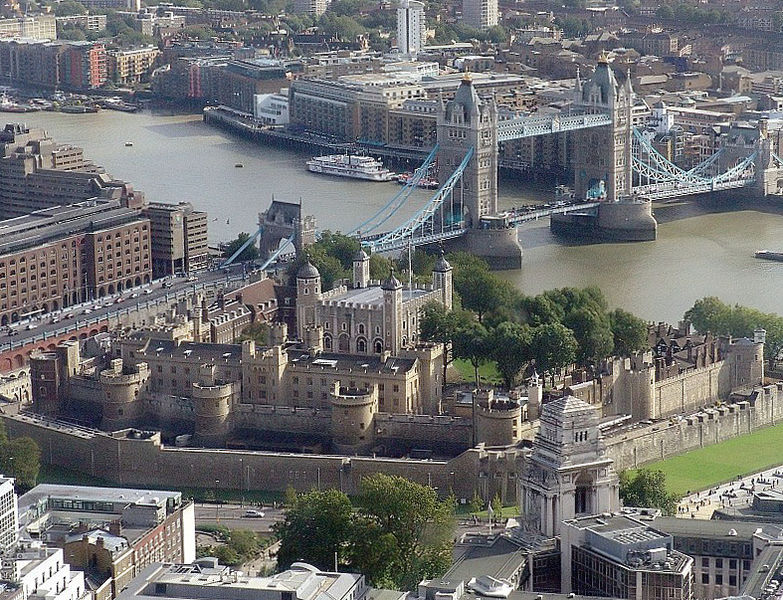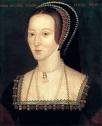
Fast facts about the Tower |
UNESCO World Heritage site
36 Yeoman Warders, dressed in Tudor uniforms and known as "Beefeaters" guard the Tower of London.
Tower Green was where aristocats were executed including 2 of Henry VIII's wives.
Legend says that if the Tower's celebrated colonony of ravens ever leave the Tower, the kingdom will fall - so as not to tempt fate - their wings are clipped.
Animals given to various monarchs were kept in the Lion Tower until 1834.
The one-hundred-foot-wide moat was drained by order of Queen Victoria in 1843 and filled to a height of fifteen feet with oyster shells.
The Imperial State Crown contains more than 2,800 diamonds.
Many high-ranking prisoners often had a retinue of servants when they were held in the Beauchamp Tower.
The highlights of the Tower of London include:
* White Tower - Its walls vary in thickness from 15 feet at the base to eleven feet at the top.
* Chapel of St. John - the best preserved Romanesque chapel in England
* Jewel House - During World War II the crown jewels were moved to a hiding place that is still a state secret. During the Commonwealth period 1649-60 most of the Crown jewels were sold or melted down.
* Traitors' Gate - This heavy iron and wood gate admitted prisoners that were brought to the Tower by barge - charged with treason.
The Tower in Literature
The Tower of London, as a place of death, darkness and treachery, is most famously evoked in William Shakespeare's play, Richard III, where it forms the backdrop of a tyrant's rise to power and the scene of the notorious murder of the Princes in the Tower, amongst other victims.
|
The Tower of London is a historic monument in the centre of London, England, on the north bank of the River Thames. The Tower is located in the London Borough of Tower Hamlets, at the eastern boundary of the City of London financial district, adjacent to the River Thames and Tower Bridge. Between the river and the Tower is Tower Wharf, a freely accessible walkway with views of the river, tower and bridge, together with HMS Belfast and London City Hall on the opposite bank.
The Tower was founded by William the Conqueror almost 1,000 years ago and its primary function was a fortress, a royal palace, and a prison . It was here that Anne Boleyn was excecuted. Guy Fawkes interrogated. Richard II and Elizabeth I incarcerated and the 'Princes in the Tower' disappeared without trace.
The White Tower
At the centre of the Tower of London stands the Norman White Tower built in 1078 by William the Conqueror (reigned 1066-87) inside the southeast angle of the city walls, adjacent to the Thames. This was built to protect the Normans from the people of the City of London and to protect London from outside invaders. Fine Caen stone, imported from France, was used for the corners of the building. According to legend the mortar used in its construction was tempered by the blood of beasts.
The Inmost Ward
In the early thirteenth century Henry III (reigned 1216-72) transformed the Tower into a major royal residence and had palatial buildings constructed within the Inner Bailey to the south of the White Tower. The Tower remained a royal residence until the time of Oliver Cromwell, who demolished some of the old palatial buildings.
The Inner Ward
The White Tower and Inmost Ward are situated in the Inner Ward, defended by a massive curtain wall, built by Henry III from 1238 onwards. In order to extend the circuit the city wall to the east was broken down, despite the protests of the citizens of London and even supernatural warnings. The wall has thirteen towers.
The Outer Ward
Between 1275 and 1285 by Edward I (reigned 1272-1307) built an outer curtain wall, completely enclosing the inner wall and thus creating a concentric double defence. He filled in the moat and built a new moat around the new outer wall. The space between the walls is called the Outer Ward. The wall has five towers facing the river
The water entrance to the Tower is often referred to as Traitor's Gate because prisoners accused of treason such as Queen Anne Boleyn and Sir Thomas More are said to have passed through it.
The Western Entrance and Moat
The Middle Tower (centre) guards the outer perimeter entrance across the (now) dry moat. A ditch or moat, now dry, encircles the Tower.
Special Events
A spectacular programme of special events runs throughout the year. Costumed guides bring the intrigue, tales and daring exploits associated with The Tower to life.
Ravens
The Ravens are one of The Tower's most famous sights. It had been thought that there have been at least six ravens in residence at the tower for centuries. It was said that Charles II ordered their removal following complaints from the Royal Astronomer. However, they were not removed because of the legend that if the ravens ever leave the Tower of London, the White Tower, the monarchy, and the entire kingdom would fall. Charles was not prepared to take the chance, and instead had the observatory moved to Greenwich.
The ravens' wings are clipped to prevent them from flying away, though they are free to roam the tower grounds, and they are cared for by the Ravenmaster. The ravens have names and are identified by gender/age. The oldest raven ever to serve at the Tower of London was called Jim Crow, who died at the age of 44.
|
 |
Torture At The Tower
 |
Inside the torture chambers of the tower various implements of torture were used. Anne Askew is the only woman on record to have been tortured in the tower, after being taken there in 1546 on a charge of heresy.
Lower-class criminals were usually executed by hanging at one of the public execution sites outside the Tower. High-profile convicts, such as Sir Thomas More, were publicly beheaded on Tower Hill. Several nobles were beheaded privately inside the complex, and then buried in the "Chapel Royal of St. Peter ad Vincula".
When Edward IV died, he left two young sons behind: the Princes in the Tower. His brother Richard, the Duke of Gloucester, was made Regent until the older of his two sons, Edward V, should come of age. Richard hired men to kill them, and, one night, the two Princes were smothered with their pillows. Many years later, bones were found buried at the foot of a stairway in the Tower, which are thought to be those of the princes. The last execution at the Tower was that of German spy Josef Jakobs on 14 August 1941. |
Crown Jewels
The Crown Jewels have been kept at the Tower of London since 1303, after they were stolen from Westminster Abbey. Most, if not all, were recovered shortly afterwards. After the coronation of Charles II, they were locked away and shown for a viewing fee paid to a custodian.
However, this arrangement ended when Colonel Thomas Blood stole the Crown Jewels after having bound and gagged the custodian. Thereafter, the Crown Jewels were kept in a part of the Tower known as Jewel House, with armed guards.
|
 |
Ghosts
 |
The Tower of London is reputedly the most haunted building in England. The ghost of Queen Anne Boleyn, beheaded in 1536 for treason against King Henry VIII, has allegedly been seen haunting the chapel of St Peter-ad-Vincula, where she is buried, and walking around the White Tower carrying her head under her arm.
Other ghosts include Henry VI, Lady Jane Grey, Margaret Pole, and the Princes in the Tower. In January 1816 a sentry on guard outside the Jewel House witnessed an inexplicable apparition of a bear advancing towards him. The sentry reportedly died of fright a few days later.
|
Coins and Kings; The Royal Mint at the Tower
Originally located for over 500 years an exhibit devoted to telling the history of the Mint at the Tower will open in May 2013. Explore six key 'moments' including Isaac Newton's efforts to rid London of counterfeiters when he was Warden of the Mint. Learn of Edward I's harsh punishmentsfor people who tampered with his coins, Elizabeth I's restoration of the coinage following her father Henry VIII’s disastrous meddling, and Charles II's rejection of Commonwealth money.
Tickets: Adult £19, Concession £16, under 16 £9.50 , under 5 Free, Family ticket (2 adults, 3 children) £50
Beefeater Tours
Share the secrets of one thousand years of royal gossip and intrigue with a Beefeater, or to give them their proper title ‘Yeoman Warder'. This body of men and one woman has guarded the fortress for centuries. Take one of their tours and you'll be amazed and possibly appalled by tales that have been passed down for generations. Pain and passion, treachery and torture, all delivered with their inimitable style!
Opening Times
Open everyday, except 24th - 26th December, 1st Jan
01 March - 31 October
Tuesday to Saturday: Opens 09.00h - 17.30h
Monday & Sunday: Opens 10.00h - 17.30h
Last admission 17.00h
01 November - 29 February
Tuesday to Saturday: Opens 09.00h - 16.30h
Monday & Sunday: Opens 10.00h - 16.30h)
Last admission 16.00h
All internal buildings close 30 minutes after the last admission. The Tower closes one hour after last admission.
Allow 2-3 hours for your visit.
The Tower is closed 24-26 December (inclusive) and 1 January.
Admission Charges: Adult £19.50; Senior/Student £16.50; Child £9.75; Under 5yrs Free; Family (2+3) or (1+4) £52.00.
Address: Tower Hill, EC3N 4AB
Phone: 0870 756 6060
The nearest London Underground station is Tower Hill. (District and Circle lines).
The nearest Docklands Light Railway station is Tower Gateway.
The nearest London Overground station is Fenchurch Street. (National Rail)
|